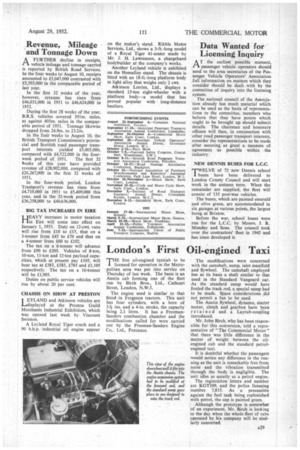Oil-engined Taxi
Page 31

If you've noticed an error in this article please click here to report it so we can fix it.
The modifications were concerned with the camshaft, sump, inlet manifold and flywheel. The camshaft employed has as its basis a shaft similar to that used in the Standard Vanguard car. As the standard sump would have fouled the track rod, a special sump had to be made. Space considerations did not permit a fan to be used.
The Austin flywheel, dynamo, starter motor, clutch and gearbox have been retained and a Layrub-coupling introduced.
Mr. John Birch, who his been responsible for this conversion, told a representative of "The Commercial Motor" that there was little difference in the matter of weight between the oilengined cab and the standard petrolengined taxi.
It is doubtful whether the passengers would notice any difference in the running as the unit is remarkably free from noise and the vibration transmitted through the body is negligible. The unit idles as quietly as a petrol engine.
The registration letters and number are KGT109, and the police licensing number 7,815. As a precaution against the fuel tank being replenished with petrol, the cap is painted green.
Although the prototype is somewhat of an experiment, Mr. Birch is looking to the day when the whole fleet of cabs operated by his company will be similarly converted.




















































































